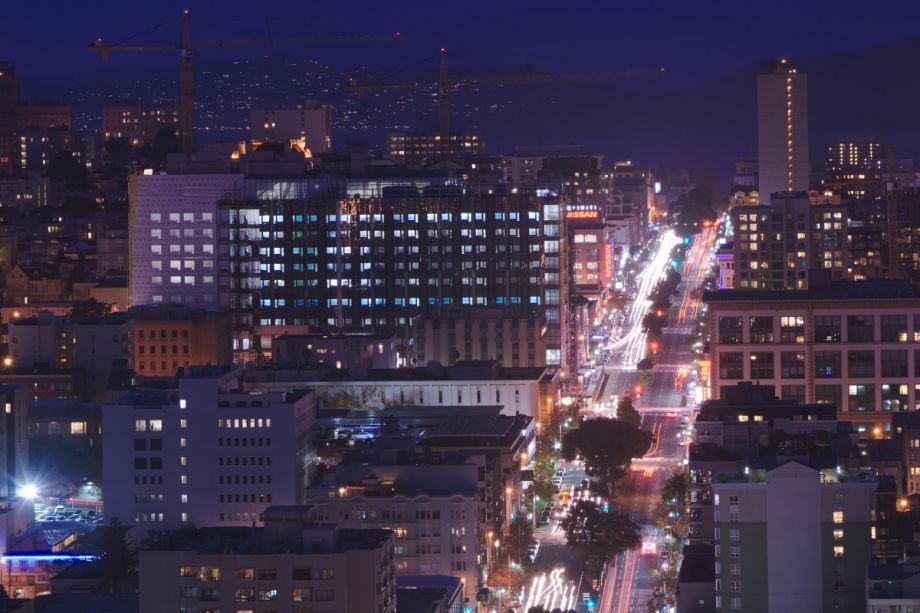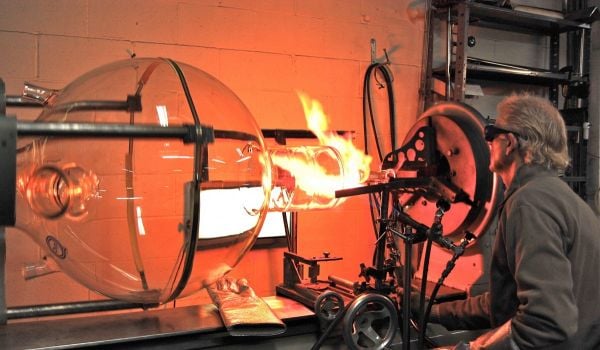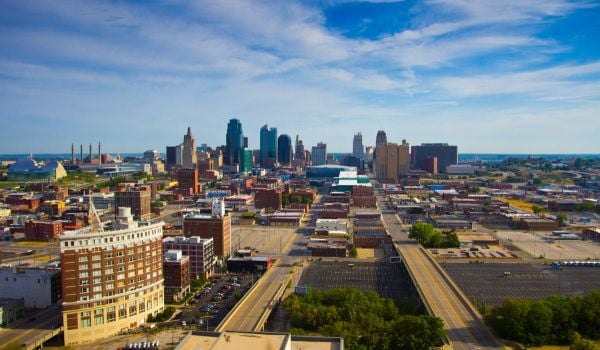San Francisco transit planners have been talking about building bus rapid transit for the better part of two decades. But while it will be at least another three years before BRT hits the city’s streets, there are two lines in the works, and both recently took important steps toward becoming reality.
In late December, the Federal Transit Administration announced it was awarding $75 million to help fund the Van Ness Avenue bus rapid transit project. On Jan. 5, the San Francisco Board of Supervisors approved designs for the Geary bus rapid transit line.
The north-south Van Ness Ave. is getting 2 miles of dedicated bus lane down the center median with nine stops from Union to Mission streets. Riders will be able to board through all doors, buses will get traffic signal prioritization and most left turns for other vehicles will be eliminated along the line. All told, the San Francisco County Transportation Authority (SFCTA) estimates the improvements will reduce transit travel time by 33 percent on the corridor.
“It’s really what bus rapid transit should be,” says Peter Straus, an advocate with San Francisco Transit Riders, referring to the dedicated bus right-of-way through the whole corridor.
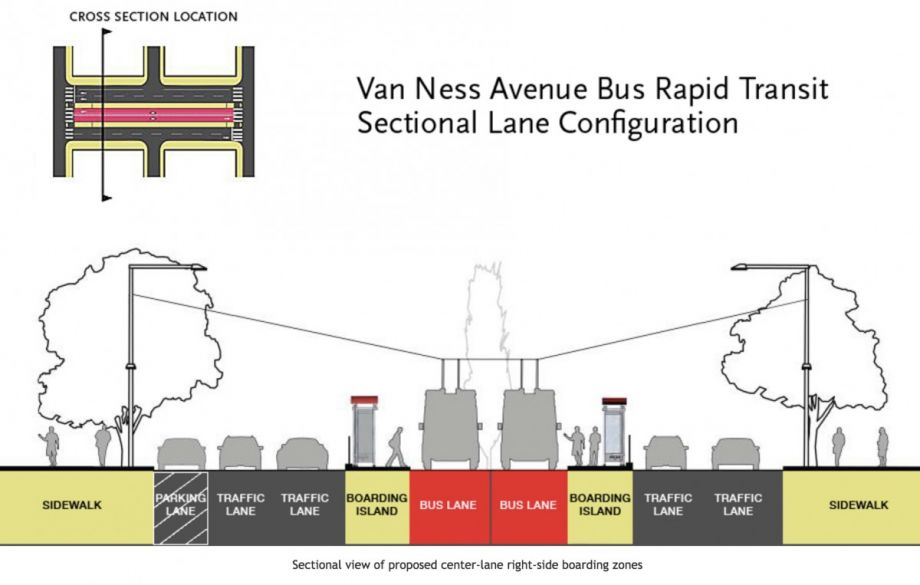
Van Ness Avenue bus rapid transit configuration in San Fransisco (Credit: SFCTA)
The first phase of construction on the $223 million project began in October. The city is replacing an 1800s-era water main, updating street lights and upgrading sewer utilities. Bus lane construction is supposed to begin in 2018 with the project opening to the public two years later.
Existing traditional bus service on Geary serves over 52,000 riders each day. Running nearly the width of the city from west to east, current bus trips can take as long as 55 minutes from one end to the other. The $300 million project is slated to reduce travel times by about 24 percent.
But where Van Ness is Straus’ ideal bus rapid transit design, he says he doesn’t see the current Geary design as a viable long-term solution for the street.
SFCTA refers to Geary as a “hybrid approach.” There will be dedicated, center-median bus lanes on a 1.7-mile section of the project between Arguello Boulevard and 27th Avenue. But buses will have to drive in dedicated curb lanes for 6.5 miles.
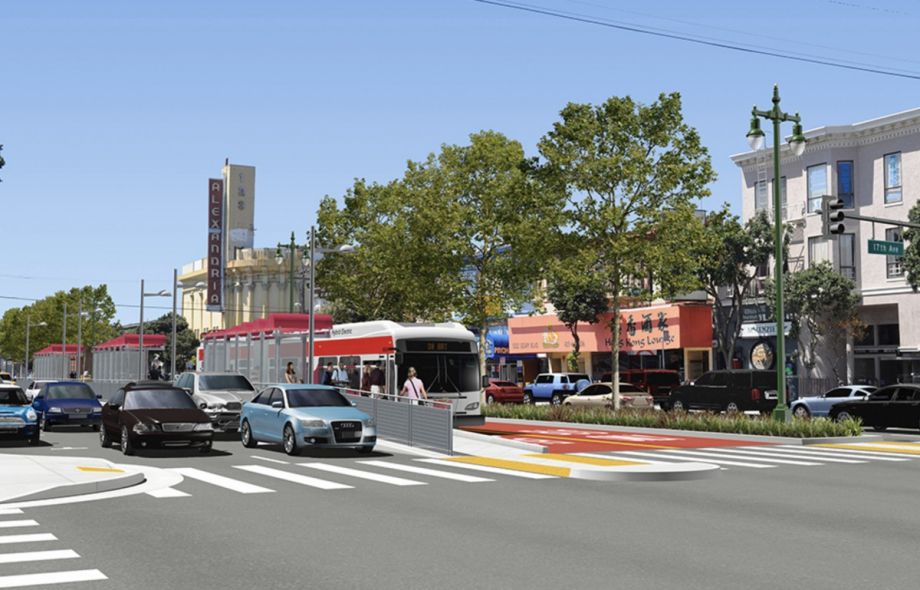
Rendering of center-lane BRT on Geary Boulevard in San Fransisco (Credit: SFCTA)
The hybrid design stems in part from physical constraints — such as the section of Geary that passes under Fillmore Street — and in part as a response to calls from business owners along the line to preserve more parking.
“Given all that, the side-lane treatment and short-term improvements are appropriate for now,” says Straus. “But we need to think about how to evolve that project over time and we should lay out a course for that now.”San Francisco Transit Riders has advocated for more dedicated center right-of-way in the design including eventually filling in the Fillmore underpass (which would cost another $50 million) and consolidating some of the bus stops to speed up service. Long term they hope to see either a Geary subway line or a light-rail line replacing the center median rapid bus service.
“The Geary plan is taking bus rides that are roughly 55 minutes from the end of line to downtown and saying ‘well let’s cut it to 55 to 45 minutes and go home,’ and we just don’t think that’s good enough,” Straus explains.
The Geary design still needs federal approval, which is likely to come within a few months. Construction is supposed to start in 2019.
Though San Francisco’s bus rapid transit is still several years away, the greater Bay Area is slated to get its first bus rapid transit systems up and running later this year. The Alameda-Contra Costa Transit Authority is constructing a 9.5-mile system that will run on International Boulevard between downtown Oakland and San Leandro. Further south, San Jose is slated to open the 7-mile Alum Rock-Santa Clara bus rapid transit line this year as well.
Transit advocates hope that having bus rapid transit up and running will help garner support for the concept.
“We don’t have any projects on the ground right now in the Bay Area that we can point to,” says Chris Lepe of TransForm, a local walkability/transit advocacy nonprofit. “People react to seeing things in person, having something tangible. Once we start seeing service in Oakland and San Jose later this year, more people will start to get excited about BRT.”
Editor’s Note: A previous version of this article incorrectly stated the FTA is awarding money for BRT to the San Francisco County Transportation Authority. The money will go to the San Francisco Municipal Transportation Agency. The SFCTA led the planning and environmental review process for the Van Ness line. SF Muni is in charge of implementation and construction.

Josh Cohen is Crosscut’s city reporter covering Seattle government, politics and the issues that shape life in the city.
Follow Josh .(JavaScript must be enabled to view this email address)

